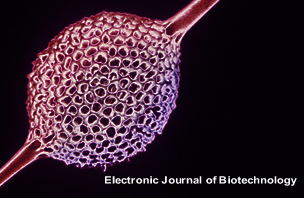Ver ítem
- xmlui.general.dspace_homeCentros e Institutos de InvestigaciónCICVyA. Centro de Investigación en Ciencias Veterinarias y AgronómicasInstituto de BiotecnologíaArtículos científicosxmlui.ArtifactBrowser.ItemViewer.trail
- Inicio
- Centros e Institutos de Investigación
- CICVyA. Centro de Investigación en Ciencias Veterinarias y Agronómicas
- Instituto de Biotecnología
- Artículos científicos
- Ver ítem
Isolation and characterization of the tissue and development-specific potato snakin-1 promoter inducible by temperature and wounding
Resumen
Snakin-1 (StSN1) is a broad-spectrum antimicrobial peptide isolated from Solanum tuberosum. Homologous proteins have been identified in a wide range of species but there is no apparent consensus in the roles they play. A 1394 bp fragment of the 5’upstream region of StSN1 gene, designated PStSN1, was isolated from the potato genome and sequenced. Bioinformatics analyses revealed a total of 55 potential regulatory motifs related to tissue-specificity,
[ver mas...]
Snakin-1 (StSN1) is a broad-spectrum antimicrobial peptide isolated from Solanum tuberosum. Homologous proteins have been identified in a wide range of species but there is no apparent consensus in the roles they play. A 1394 bp fragment of the 5’upstream region of StSN1 gene, designated PStSN1, was isolated from the potato genome and sequenced. Bioinformatics analyses revealed a total of 55 potential regulatory motifs related to tissue-specificity, stress, defence and hormone responsiveness, among others. PStSN1 spatial and temporal activity was studied in transgenic Arabidopsis plants expressing a reporter gene under this promoter control (PStSN1::GUS). Histochemical staining revealed PStSN1::GUS expression in the root vasculature, cotyledons, young leaves and floral organs. Moreover, GUS staining was detected in young developmental stages gradually decreasing as the plant aged. Stress treatments on transgenic plants showed that PStSN1 activity was induced by high/low temperature and wounding. The characterization of PStSN1 in a model plant establishes a framework for the understanding of its possible biological functions and provides a potential tool for plant modification through genetic engineering.
[Cerrar]

Fuente
Electronic journal of biotechnology 13 (5) : 1-21. (Septiembre 2010)
Fecha
2010-09
Editorial
Pontificia Universidad Catolica de Valparaiso
ISSN
0717-3458
Formato
pdf
Tipo de documento
artículo
Palabras Claves
Derechos de acceso
Abierto
 Excepto donde se diga explicitamente, este item se publica bajo la siguiente descripción: Creative Commons Attribution-NonCommercial-ShareAlike 2.5 Unported (CC BY-NC-SA 2.5)
Excepto donde se diga explicitamente, este item se publica bajo la siguiente descripción: Creative Commons Attribution-NonCommercial-ShareAlike 2.5 Unported (CC BY-NC-SA 2.5)


